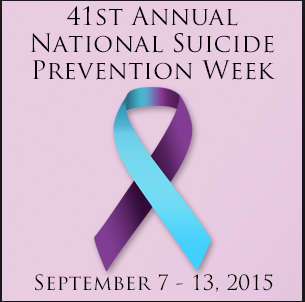
September 10th, is World Suicide Prevention Day. In fact, the entire week of September 7th through September 13th is our nation’s 41st Annual Suicide Prevention Week. I couldn’t let these dates go by without taking the time to talk to you about the most preventable form of death: suicide.
Sadly, the statistics1 surrounding suicide and suicide attempts are staggering. In our country, one person takes his/her life every 12.8 minutes. Suicide ranks 10th in the list of leading causes of death; homicide ranks 16th. Further, for every one completion there are an estimated 25 attempts. A recent report suggests that for every death by suicide, 115 people are affected by the loss. Twenty-five of those people will have a major life disruption. Yet, with statistics like these you rarely ever hear discussions about death by suicide.
Suicide is everyone’s problem.
Knowing the warning signs of suicide2 and how to respond to them appropriately can save someone’s life. Here are some of the most common warning signs:
- Preoccupation with death and dying
- Drastic changes in behavior or personality
- A recent severe loss (such as a relationship) or threat of a loss
- Unexpected preparations for death such as making out a will
- Giving away prized possessions
- A previous suicide attempt
- Uncharacteristic impulsiveness, recklessness, or risk-taking
- Loss of interest in personal appearance
- Increased use of alcohol or drugs
- Sense of hopelessness about the future
If you sense someone might be struggling with suicidal thoughts, don’t hesitate to talk to them about it. Talking with someone about suicide won’t put the idea in their heads. It is likely that if you are seeing any one of the warning signs, they’ve already been contemplating taking their own life.
It is imperative to ask the question, regardless of whether it is directly (Are you thinking of suicide?) or indirectly (You know sometimes people who are feeling the way you are think about killing themselves, are you thinking that?). If you are not comfortable talking to someone about suicide, get someone else involved. It may seem like an awkward conversation but, like any other topic that we might feel uncomfortable discussing, practice makes perfect.
Want to learn more? “Gatekeeper” training sessions can help you:
- be more observant of warning signs
- have a conversation with someone struggling
- know where you can take someone who might need professional help
Texas has also developed a gatekeeper training online which is accessible free of charge at the following link: http://www.texassuicideprevention.org/training/video-training-lessons-guides/ask-about-suicide-ask/.
Death is scary and knowing someone who might be thinking of killing themselves is even scarier but suicide is preventable. We can no longer ignore the suffering and hopelessness that someone feels and hope that a professional will intervene. We would never walk past a person bleeding and say “man you have lost a lot of blood, you should get to a doctor” or someone choking and say “sounds pretty lodged in there too much for me to handle”. We would instead apply pressure to the person bleeding and immediately start the Heimlich maneuver on someone choking. We must be prepared to help someone that is suffering with thoughts of suicide. The solution belongs to everyone.
Finally, I would encourage each of you to save this number in your phone right now. 1-800-273-TALK (8255) this might be the most important number you ever save in your phone. Who knows, it may even help you save a life.
- Obtained 6 January 2015 from CDC/NCHS’s Mortality in the United States: 2013 Public Use File and Web Tables (released 30 December 2014; Table 19)
- http://www.texassuicideprevention.org/how-you-can-help/how-to-help-know-the-signs/